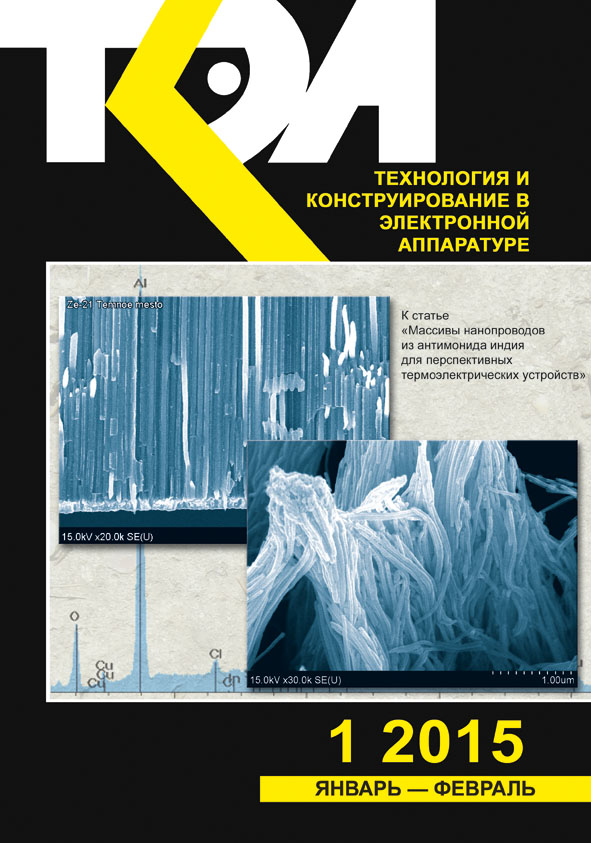Influence of the effectiveness of raw materials on the reliability of thermoelectric cooling devices. Part I: single-stage TEDs
Abstract
Increase of the reliability of information systems depends on the reliability improvement of their component elements, including cooling devices, providing efficiency of thermally loaded components. Thermoelectric devices based on the Peltier effect have significant advantages compared with air and liquid systems for thermal modes of the radio-electronic equipment. This happens due to the absence of moving parts, which account for the failure rate.
The article presents research results on how thermoelectric efficiency modules affect the failure rate and the probability of non-failure operation in the range of working temperature of thermoelectric coolers. The authors investigate a model of relative failure rate and the probability of failure-free operation single-stage thermoelectric devices depending on the main relevant parameters: the operating current flowing through the thermocouple and resistance, temperature changes, the magnitude of the heat load and the number of elements in the module.
It is shown that the increase in the thermoelectric efficiency of the primary material for a variety of thermocouple temperature changes causes the following: maximum temperature difference increases by 18%; the number of elements in the module decreases; cooling coefficient increases; failure rate reduces and the probability of non-failure operation of thermoelectric cooling device increases. Material efficiency increase by 1% allows reducing failure rate by 2.6 – 4.3% in maximum refrigeration capacity mode and by 4.2 – 5.0% in minimal failure rate mode when temperature difference changes in the range of 40 – 60 K.
Thus, the increase in the thermoelectric efficiency of initial materials of thermocouples can significantly reduce the failure rate and increase the probability of failure of thermoelectric coolers depending on the temperature difference and the current operating mode.
References
Zaikov V. P., Moiseev V. F. [Effect of operating a thermoelectric device on its reliability] Tekhnologiya i konstruirovanie v elektronnoi apparature, 2001, no 4-5, pp. 30-32. (Rus)
Zaikov V. P., Kinshova L. A., Moiseev V. F., Efremov V. I., Melnik Yu. V. [Choice of operation mode of the thermoelectrical cooling device, ensuring the minimal failure rate]. Tekhnologiya i konstruirovanie v elektronnoi apparature, 2008, no 2, pp. 45-47. (Rus)
Zaikov V. P., Kinshova L. A., Marchenko V.I. [Effect of the heat load on reliability parameters of the thermoelectric device]. Teplovye rezhimy i okhlazhdenie REA, 2003, iss. 1, pp. 56-62. (Rus)
Zaikov V. P., Kinshova L. A., Moiseev V. F. Prognozirovanie pokazatelei nadezhnosti termoelektricheskikh okhlazhdayushchikh ustroistv. Kniga 1. Odnokaskadnye ustroistva [Forecasting reliability performance of thermoelectric cooling devices. Book 1. Single stage device]. Odessa, Politehperiodika, 2009, 118 p. (Rus)
Lau P.S., Neiji M.J. [Evaluation of reliability of thermoelectric coolers] Termicheskoe oborudovanie. Tekhnologiya, 2004, iss. 1, pp. 43-46. (Rus)
Iversen B.B., A Palmqvist.E., Cox D.E., Nolas G.S., Stucky G.D., Blake N.P., Metiu H. Why are clathrates good candidates for thermoelectric materials. Solid State Chem., 2000, vol. 149, pp. 455-458.
Riffat S.R., Xiaoli M. Improving the coefficient of performance of thermoelectric cooling systems. Internation journal of energy research, 2004, vol. 28, pp. 78-85.
Kolenko E.A., Stil'bans L.S. [Thermoelectric coolers]. Poluprovodniki v nauke i tekhnike. Izd-vo AN SSSR, 1958, pp. 249-250. (Rus)
Copyright (c) 2015 Zaikov V. P., Meshcheryakov V. I., Gnatovskaya A. A., Zhuravlev Yu. I.

This work is licensed under a Creative Commons Attribution 4.0 International License.

